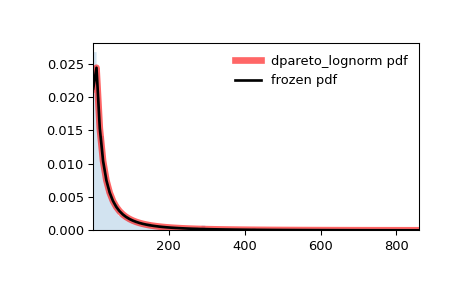scipy.stats.dpareto_lognorm#
- scipy.stats.dpareto_lognorm = <scipy.stats._continuous_distns.dpareto_lognorm_gen object>[source]#
A double Pareto lognormal continuous random variable.
As an instance of the
rv_continuousclass,dpareto_lognormobject inherits from it a collection of generic methods (see below for the full list), and completes them with details specific for this particular distribution.Methods
rvs(u, s, a, b, loc=0, scale=1, size=1, random_state=None)
Random variates.
pdf(x, u, s, a, b, loc=0, scale=1)
Probability density function.
logpdf(x, u, s, a, b, loc=0, scale=1)
Log of the probability density function.
cdf(x, u, s, a, b, loc=0, scale=1)
Cumulative distribution function.
logcdf(x, u, s, a, b, loc=0, scale=1)
Log of the cumulative distribution function.
sf(x, u, s, a, b, loc=0, scale=1)
Survival function (also defined as
1 - cdf, but sf is sometimes more accurate).logsf(x, u, s, a, b, loc=0, scale=1)
Log of the survival function.
ppf(q, u, s, a, b, loc=0, scale=1)
Percent point function (inverse of
cdf— percentiles).isf(q, u, s, a, b, loc=0, scale=1)
Inverse survival function (inverse of
sf).moment(order, u, s, a, b, loc=0, scale=1)
Non-central moment of the specified order.
stats(u, s, a, b, loc=0, scale=1, moments=’mv’)
Mean(‘m’), variance(‘v’), skew(‘s’), and/or kurtosis(‘k’).
entropy(u, s, a, b, loc=0, scale=1)
(Differential) entropy of the RV.
fit(data)
Parameter estimates for generic data. See scipy.stats.rv_continuous.fit for detailed documentation of the keyword arguments.
expect(func, args=(u, s, a, b), loc=0, scale=1, lb=None, ub=None, conditional=False, **kwds)
Expected value of a function (of one argument) with respect to the distribution.
median(u, s, a, b, loc=0, scale=1)
Median of the distribution.
mean(u, s, a, b, loc=0, scale=1)
Mean of the distribution.
var(u, s, a, b, loc=0, scale=1)
Variance of the distribution.
std(u, s, a, b, loc=0, scale=1)
Standard deviation of the distribution.
interval(confidence, u, s, a, b, loc=0, scale=1)
Confidence interval with equal areas around the median.
Notes
The probability density function for
dpareto_lognormis:\[f(x, \mu, \sigma, \alpha, \beta) = \frac{\alpha \beta}{(\alpha + \beta) x} \phi\left( \frac{\log x - \mu}{\sigma} \right) \left( R(y_1) + R(y_2) \right)\]where \(R(t) = \frac{1 - \Phi(t)}{\phi(t)}\), \(\phi\) and \(\Phi\) are the normal PDF and CDF, respectively, \(y_1 = \alpha \sigma - \frac{\log x - \mu}{\sigma}\), and \(y_2 = \beta \sigma + \frac{\log x - \mu}{\sigma}\) for real numbers \(x\) and \(\mu\), \(\sigma > 0\), \(\alpha > 0\), and \(\beta > 0\) [1].
dpareto_lognormtakesuas a shape parameter for \(\mu\),sas a shape parameter for \(\sigma\),aas a shape parameter for \(\alpha\), andbas a shape parameter for \(\beta\).A random variable \(X\) distributed according to the PDF above can be represented as \(X = U \frac{V_1}{V_2}\) where \(U\), \(V_1\), and \(V_2\) are independent, \(U\) is lognormally distributed such that \(\log U \sim N(\mu, \sigma^2)\), and \(V_1\) and \(V_2\) follow Pareto distributions with parameters \(\alpha\) and \(\beta\), respectively [2].
The probability density above is defined in the “standardized” form. To shift and/or scale the distribution use the
locandscaleparameters. Specifically,dpareto_lognorm.pdf(x, u, s, a, b, loc, scale)is identically equivalent todpareto_lognorm.pdf(y, u, s, a, b) / scalewithy = (x - loc) / scale. Note that shifting the location of a distribution does not make it a “noncentral” distribution; noncentral generalizations of some distributions are available in separate classes.References
[1]Hajargasht, Gholamreza, and William E. Griffiths. “Pareto-lognormal distributions: Inequality, poverty, and estimation from grouped income data.” Economic Modelling 33 (2013): 593-604.
[2]Reed, William J., and Murray Jorgensen. “The double Pareto-lognormal distribution - a new parametric model for size distributions.” Communications in Statistics - Theory and Methods 33.8 (2004): 1733-1753.
Examples
>>> import numpy as np >>> from scipy.stats import dpareto_lognorm >>> import matplotlib.pyplot as plt >>> fig, ax = plt.subplots(1, 1)
Get the support:
>>> u, s, a, b = 3, 1.2, 1.5, 2 >>> lb, ub = dpareto_lognorm.support(u, s, a, b)
Calculate the first four moments:
>>> mean, var, skew, kurt = dpareto_lognorm.stats(u, s, a, b, moments='mvsk')
Display the probability density function (
pdf):>>> x = np.linspace(dpareto_lognorm.ppf(0.01, u, s, a, b), ... dpareto_lognorm.ppf(0.99, u, s, a, b), 100) >>> ax.plot(x, dpareto_lognorm.pdf(x, u, s, a, b), ... 'r-', lw=5, alpha=0.6, label='dpareto_lognorm pdf')
Alternatively, the distribution object can be called (as a function) to fix the shape, location and scale parameters. This returns a “frozen” RV object holding the given parameters fixed.
Freeze the distribution and display the frozen
pdf:>>> rv = dpareto_lognorm(u, s, a, b) >>> ax.plot(x, rv.pdf(x), 'k-', lw=2, label='frozen pdf')
Check accuracy of
cdfandppf:>>> vals = dpareto_lognorm.ppf([0.001, 0.5, 0.999], u, s, a, b) >>> np.allclose([0.001, 0.5, 0.999], dpareto_lognorm.cdf(vals, u, s, a, b)) True
Generate random numbers:
>>> r = dpareto_lognorm.rvs(u, s, a, b, size=1000)
And compare the histogram:
>>> ax.hist(r, density=True, bins='auto', histtype='stepfilled', alpha=0.2) >>> ax.set_xlim([x[0], x[-1]]) >>> ax.legend(loc='best', frameon=False) >>> plt.show()
